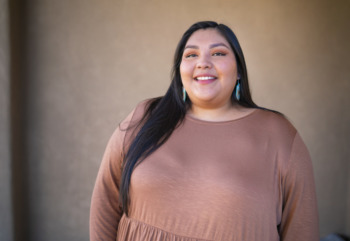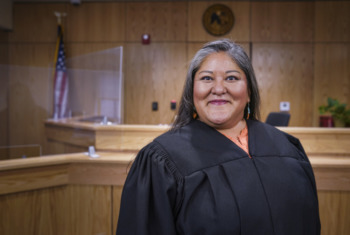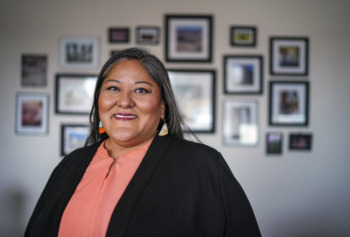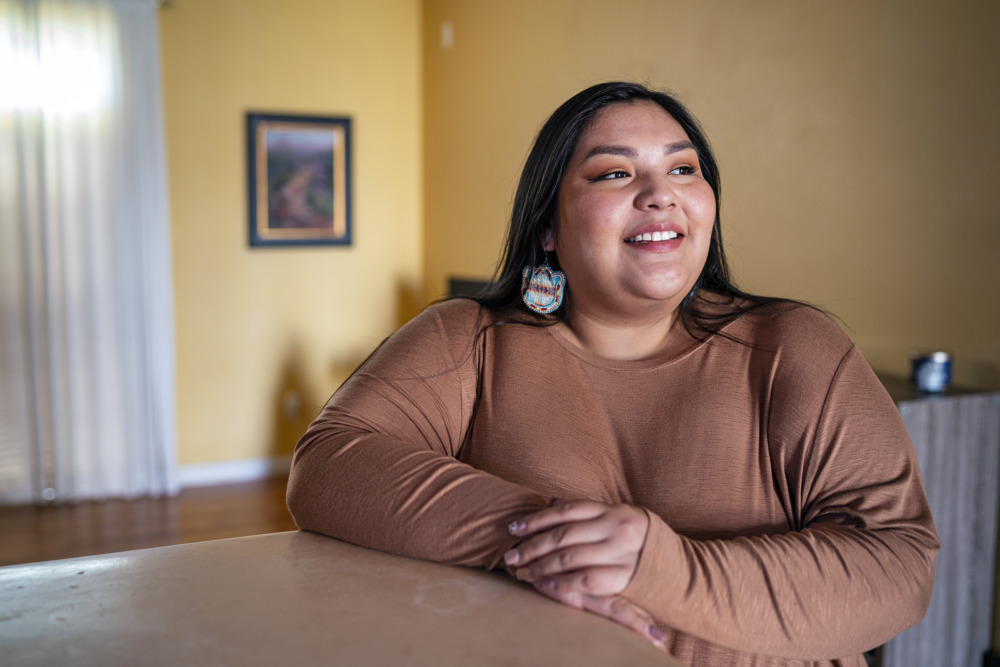Veronica Krupnick, a member of the Hopi Tribe who also has Navajo and Jemez Pueblo heritage, was six years old when she entered New Mexico’s child welfare system, ultimately severing her connections to her family, community and culture.
“It felt like my whole world was completely different,” said Krupnick, now 26 and a program coordinator for foster youth advocacy with New Mexico’s court-appointed special advocates. “It’s really hard to function fully when your whole world just gets turned upside down.”
Today, a case like Krupnick’s would come before New Mexico’s Native family court, which was inaugurated in January, 2020, with the intention of helping prevent the separation of Indigenous children from their families and tribes. The court, based in Albuquerque, is dedicated to hearing child welfare cases that fall under the Indian Child Welfare Act, or ICWA.
Child welfare advocates, attorneys and court officials say the court has already achieved success in keeping families together by strengthening tribal involvement.
The fact that none of the cases to come before the ICWA court has resulted in termination of parental rights is “a big deal,” said Bette Fleishman, the executive director of Pegasus Legal Services for Children, an Albuquerque-based law firm that represents a majority of the children who appear before the court, and which was involved in its planning.
“The intent of all foster care, but much more with the Indian court, the ICWA court, is to reunite these kids back with their families, back with their tribes, back with their culture as soon as possible,” Fleishman said.
Native children more likely to be removed from their families
ICWA, enacted in 1978, was intended to address a widespread crisis of Native American children being separated from their families and tribal communities by non-Native entities, primarily state child welfare departments and private adoption agencies.

Gabriela Campos
Krupnick says her adoptive parents were supportive, but the separation from her culture and community was painful.
Studies indicate that until ICWA, up to a third of Native children in the U.S. were experiencing this kind of removal, and that 85 percent of that population were placed outside their families and communities, even if suitable relatives were available to take them in.
An American Indian child is still four times likelier than a non-Native child to be removed from their parents. A main priority of New Mexico’s ICWA court is to prevent the breakup of Native families by not removing Native children from their parents or relatives absent an imminent threat, and by working with Native communities to identify placement preferences.
Krupnick, who was eventually adopted by a white couple after an attempted placement with her grandfather, recalled the pain of separation from her community. She praised her adoptive parents, whom she described as supportive, but said there was still a void in her life.
“It was definitely a big hurt for me,” she said.
Some 10 percent of the state’s foster children fall under ICWA — roughly equivalent to the percentage of the state’s Native population overall, according to the latest census data. The court had served a total of 47 children as of January.
Catherine Begaye, the ICWA court’s presiding judge, who is Navajo/Diné, was instrumental in planning the court and establishing its founding principle of tribal involvement at all stages of a case. She is the only Native American to preside over any of the sixteen ICWA courts currently in operation around the country.
Begaye said that fostering even greater tribal involvement is a primary goal of the court this year. From the perspective of the tribes, preferential placement is “how their tribe is going to survive in the future,” she said.
“It’s how they pass down their language and their culture and their traditions,” she said. “We really want to include them more directly as teachers for us in the system.”
Begaye said nearly seventy percent of the 26 children who have active ICWA cases before the court are currently in preferential placements, which are, in descending order: A member of the child’s extended family; a family elsewhere within their tribe; or with a Native family outside their tribe. Two-thirds were placed with their parents or relatives while their cases were pending.
Statewide, less than forty percent of all foster youth are placed with relatives, based on data from October, 2021.
Crucially, Begaye said, the ICWA court has “not had even a motion to terminate parental rights filed for any of our families,” even in rulings that have placed children in guardianships, nor have any of the parents made a reappearance before the court. In New Mexico, as in most states, termination of parental rights is irreversible except in specific, limited circumstances.
Going beyond the federal law

Gabriela Campos
Catherine Begaye, the ICWA court’s presiding judge, who is Navajo/Diné, is the only Native American to preside over any of the sixteen ICWA courts currently in operation around the country.
New Mexico is home to 23 sovereign tribal nations — 19 Pueblos, three Apache tribes, and part of the Navajo Nation — each of which is culturally distinct. In an effort to ensure that Native foster children can continue being raised in their tribal cultures, the New Mexican government has mandated cooperation between state entities, including the ICWA court, caseworkers, ICWA experts and other representatives from each child’s tribal nation, starting from the very beginning of each case.
“We have really committed to having the tribes at the forefront of all of our ICWA work,” said Cynthia Chavers, the field deputy director of the state’s Children, Youth and Families Department (CYFD), which oversees the state’s foster system. “The state should not be telling the tribes how we should handle ICWA cases. We need to really rely on that government-to-government relationship.”
Advocates, caseworkers, and lawyers in New Mexico have found success in certain practices that exceed the federal ICWA requirements, Chavers said. For example, she noted that the federal law requires a child’s tribe to be contacted only once that child is already in foster care and separated from family. In New Mexico, CYFD notifies a child’s tribe as soon as the state receives a report to its child welfare hotline and accepts an investigation into a child’s family.
Another important divergence with federal standards relates to the definition, Chavers said, of who can be considered a relative to a child in foster care. She noted the federal law’s relatively narrow definition of extended family with whom a child can be placed: A grandparent; step-parent; aunt or uncle; brother or sister; or first or second cousin.
“That definition doesn’t really allow the inclusion of family members from an Indian person’s perspective,” Chavers said. “There are clan relationships where there may not be a direct blood linkage from the child to that person, but they’re considered family to that child by the tribe.”
New Mexico allows its tribes to define what constitutes extended family.
“For each tribe and Pueblo, who is family to that child may look different,” Chavers said.
Lawmakers in New Mexico, led by state representative Georgene Louis, a Democrat, have enshrined such practices in state law by passing a ICWA bill in the 2022 legislative term, which ended on Thursday. The legislation now heads to the desk of the Democratic governor, Michelle Lujan Grisham, who has publicly supported the effort.
An added benefit of a state-level law, Chavers said, would be to protect ICWA practices in New Mexico from challenges to the viability of the federal ICWA, potentially from a case now before the Supreme Court: Brackeen v. Haaland, a lawsuit brought against the federal government by the states of Texas, Louisiana, and Indiana, as well as individual plaintiffs.
The suit alleges ICWA’s mandate that Native foster children be placed with Native families amounts to racial discrimination, violating the Equal Protection Clause of the 14th Amendment. The plaintiffs have also argued that by applying the law to state-level adoption proceedings, the federal government violates federalism principles protected by the 10th Amendment.
Following a controversial ruling of the law as unconstitutional in a federal district court in north Texas, the case fell to the Fifth Circuit Court of Appeals, in New Orleans, which in April released a long and convoluted ruling in which none of the opinions of its 17 judges commanded a majority, setting the stage for the Supreme Court to weigh in. ICWA activists fear an adverse ruling may invalidate the federal law altogether.
Advocates seek to expand Native family court as state child welfare agency struggles to enact reforms
CYFD is in the midst of enacting a series of reforms mandated by a separate lawsuit. The resulting agreement, known as the Kevin S. Settlement, was reached in March, 2020, by the department and a collection of litigants, including Pegasus and Public Counsel, the world’s largest pro-bono public-interest law firm, which sued CYFD in 2018 on behalf of more than a dozen youth and advocacy organizations.
The lawsuit alleged that New Mexico repeatedly failed to provide the children in its care — including Native children — with safe and stable placements, as well as necessary behavioral health services.

Gabriela Campos
Begaye says that fostering even greater tribal involvement is a primary goal of the court. Preferential placement is “how their tribe is going to survive in the future.”
One of the settlement’s four appendices focuses entirely on ICWA cases, and requires the state, with input from New Mexico’s tribes and Pueblos, to create processes promoting traditional first-line interventions for at-risk Native children; to recruit more Native families willing to foster children unrelated to them; and to assist in the offering of traditional ceremonies to Native children in the foster system, among other measures.
In their first annual report, released last year, the settlement’s co-neutrals, who are overseeing the progress of these reforms, concluded that CYFD has met performance standards for only two of the 15 requirements thus far: The creation of a dedicated ICWA unit within the department, and the hiring of a full-time employee dedicated to “culturally responsive services” for Native children in state custody.
Still, the court’s supporters point to the number of successful reunifications it has overseen, and hope to open a second court elsewhere in the state and address a backlog of older cases.
Fleishman, the attorney who frequently represents cases before the Native family court, said the benefits are similar to those of any specialized court: It is able to draw on the expertise of a smaller group of attorneys and judges dedicated to litigating a single area of law.
Fleishman credited the court’s positive outcomes to its dedication to reunification, the depth of tribal involvement and the additional allocation of resources.
“A little more advocacy,” she said. “A little extra effort.”






























